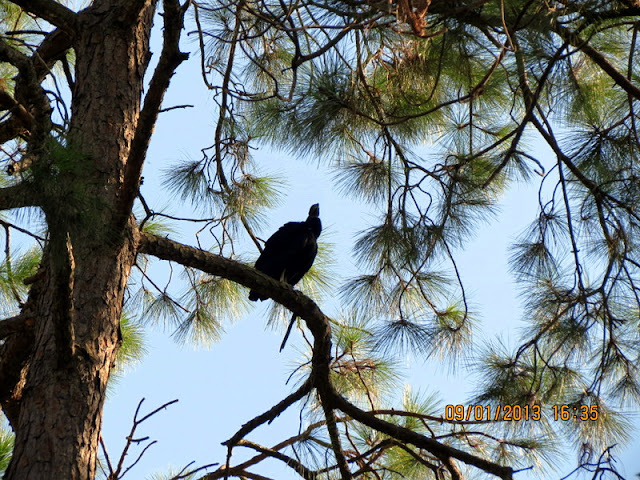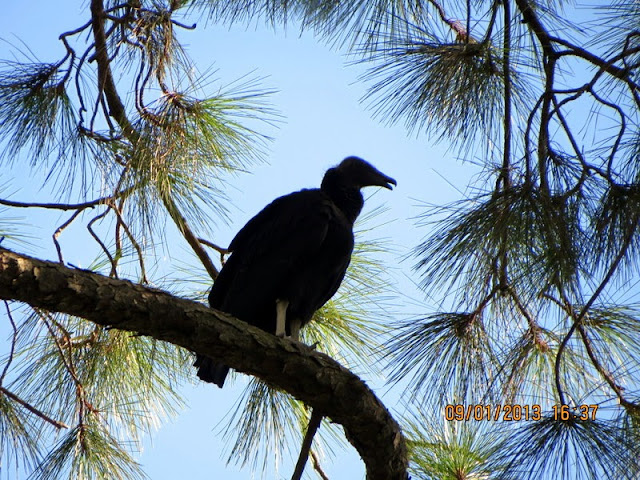Hi Everybody!!
Look who is leading the Parade bringing in September: Tiny Elisabeth the Hummingbird! Next is Snowball-the fattest hummer I have ever seen. These 2 birds have returned every September for 5 years. As I am sitting under the tall pine trees watching the hummers zip through the air, I can't help but marvel at the perfect little flying machines they are! Up above I hear something crash into a tall pine tree. I look up and it is the 5 month old Baby Buzz (still working on his rough landings!) He has come across the road and is watching me watch the hummers. As I sit here, hanging out with the birds, I think about what a strangely, wonderful family we have become! Your photostudy tonight is a glimpse into this 'family'. We are Blessed and I share this Blessing with all of You. Enjoy!
This is "Snowball" You will notice his very round appearance!
(Pleasse visit below link to view all information on this extensive page)
https://en.wikipedia.org/wiki/Bird
Bird
From Wikipedia, the free encyclopedia
Birds (class Aves or clade Avialae) are feathered, winged, bipedal, endothermic(warm-blooded), egg-laying, vertebrate animals. With around 10,000 living species, they are the most speciose class of tetrapod vertebrates. All present species belong to the subclass Neornithes, and inhabit ecosystems across the globe, from the Arctic to the Antarctic. Extant birds range in size from the 5 cm (2 in) Bee Hummingbird to the 2.75 m (9 ft) Ostrich. The fossil record indicates that birds emerged within theropoddinosaurs during the Jurassic period, around 150 million years ago. Birds are the only members of the clade originating with the earliest dinosaurs to have survived theCretaceous–Paleogene extinction event 66 million years ago.
Modern birds are characterised by feathers, a beak with no teeth, the laying of hard-shelled eggs, a high metabolic rate, a four-chambered heart, and a lightweight but strong skeleton. All living species of birds have wings; the most recent species without wings was the moa, which is generally considered to have become extinct in the 16th century. Wings are evolved forelimbs, and most bird species can fly. Flightless birds include ratites, penguins, and a number of diverse endemic island species. Birds also have unique digestive and respiratory systems that are highly adapted for flight. Some birds, especially corvids and parrots, are among the most intelligent animal species; a number of bird species have been observed manufacturing and using tools, and many social species exhibit cultural transmission of knowledge across generations.
Many species undertake long distance annual migrations, and many more perform shorter irregular movements. Birds are social; they communicate using visual signals and through calls and songs, and participate in social behaviours, including cooperative breeding and hunting, flocking, and mobbing of predators. The vast majority of bird species are socially monogamous, usually for one breeding season at a time, sometimes for years, but rarely for life. Other species have polygynous ("many females") or, rarely, polyandrous ("many males") breeding systems. Eggs are usually laid in a nest and incubated by the parents. Most birds have an extended period of parental care after hatching.
Many species are of economic importance, mostly as sources of food acquired through hunting or farming. Some species, particularly songbirds and parrots, are popular as pets. Other uses include the harvesting of guano (droppings) for use as a fertiliser. Birdsfigure prominently in all aspects of human culture from religion to poetry to popular music. About 120–130 species have become extinct as a result of human activity since the 17th century, and hundreds more before then. Currently about 1,200 species of birds are threatened with extinction by human activities, though efforts are underway toprotect them.
| Birds Temporal range: Late Jurassic–Holocene,[1] 160–0Ma | |
|---|---|
 | |
| A composite image showing the diversity of birds; 18 biological orders are depicted in this image (from top, left to right): Cuculiformes,Ciconiiformes, Phaethontiformes,Accipitriformes, Gruiformes, Galliformes,Anseriformes, Trochiliformes,Charadriiformes, Casuariiformes,Psittaciformes, Phoenicopteriformes,Sphenisciformes, Pelecaniformes,Suliformes, Coraciiformes, Strigiformes,Piciformes. | |
| Scientific classification | |
| Kingdom: | Animalia |
| Phylum: | Chordata |
| Superclass: | Tetrapoda |
| Clade: | Eumaniraptora |
| Clade: | Avialae Gauthier, 1986 |
| Class: | Aves Linnaeus, 1758[2] |
Early diversity
| ||||||||||||||||||||||||||||||||||||||||||||||||||||||||||||||||||||||||||||||||||||
| Mesozoic bird phylogeny simplified after O’Connor et al., 2013.[27] |
The first large, diverse lineage of short-tailed birds to evolve were the enantiornithes, or "opposite birds", so named because the construction of their shoulder bones was in reverse to that of modern birds. Enantiornithes occupied a wide array of ecological niches, from sand-probing shorebirds and fish-eaters to tree-dwelling forms and seed-eaters. While they were the dominant group of land birds during the Cretaceous period, enantiornithes became extinct along with many other dinosaur groups at the end of the of the Mesozoicera.[25]
Many species of the second major bird lineage to diversify, the Euornithes ("true birds", including the ancestors of modern birds), were semi-aquatic and specialized in eating fish and other small aquatic organisms. Unlike the enantiornithes, which dominated land-based and arboreal habitats, most early euornithes lacked perching adaptations and seem to have included shorebirds, waders, and swimming and diving species. The later included the superficially gull-like genusIchthyornis (fish birds),[28] the Hesperornithiformes, which became so well adapted to hunting fish in marine environments that they lost the ability to fly and became primarily aquatic.[25] The early euornithes also saw the development of many traits associated with modern birds, like strongly keeled breastbones, toothless, beaked portions of their jaws (though most non-avian euornithes retained teeth in other parts of the jaws).[29] Euornithes also included the first birds to develop true pygostyle and a fully mobile fan of tail feathers,[30] which may have replaced the "hind wing" as the primary mode of aerial maneuverability and braking in flight.[24]
Diversification of modern birds
See also: Sibley-Ahlquist taxonomy and dinosaur classification
| |||||||||||||||||||||||||||
| Basal divergences of modern birds based on Sibley-Ahlquist taxonomy |
All modern birds lie within the crown group Neornithes (alternately Aves), which has two subdivisions: the Palaeognathae, which includes the flightlessratites (such as the ostriches) and the weak-flying tinamous, and the extremely diverse Neognathae, containing all other birds.[5] These two subdivisions are often given the rank of superorder,[31] although Livezey and Zusi assigned them "cohort" rank.[5] Depending on the taxonomic viewpoint, the number of known living bird species varies anywhere from 9,800[32] to 10,050.[33]
Due largely to the discovery of Vegavis, a late Cretaceous neognath member of the duck lineage, Neornithes is now known to have split into several modern lineages by the end of the Mesozoic era.[34] The earliest divergence from the remaining Neognathes was that of the Galloanserae, the superorder containing the Anseriformes (ducks, geese, swans and screamers) and the Galliformes (the pheasants, grouse, and their allies, together with the mound builders and the guans and their allies). The dates for the splits are much debated by scientists. The Neornithes are agreed to have evolved in the Cretaceous, and the split between the Galloanseri from other Neognathes occurred before the Cretaceous–Paleogene extinction event, but there are different opinions about whether theradiation of the remaining Neognathes occurred before or after the extinction of the other dinosaurs.[35] This disagreement is in part caused by a divergence in the evidence; molecular dating suggests a Cretaceous radiation, while fossil evidence supports aTertiary radiation. Attempts to reconcile the molecular and fossil evidence have proved controversial.[35][36]
Baby Buzz comes across the road to these tall pine trees in Kates Yard. He is watching me photograph the hummers and bees!
(Coming next post: A Bowl of Bees!)
Baby Buzz and friend back across the road in his tree
...this is brendasue signing off from Rainbow Creek. See You next time!
O+O


































































No comments:
Post a Comment
Hi Everybody! Please say hello and follow so I know you are here! Due to the inconsideration of people trying to put commercials on my blog comment area, I have restricted use of anonymous posts. Sorry that some hurt all.
My public email is katescabin@gmail.com No spammers or trolls